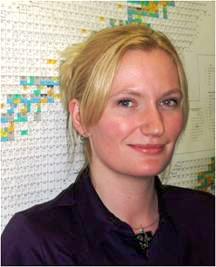| ||
Dr. Suzanne Lapi |
Earlier this month on August 4, the TeraChem* 2010 Committee announced the winners of the Marino Nicolini Prize. One of the winners is Dr. Suzanne Lapi (Suzy), who submitted a paper titled “An alternative route to the production of High Specific Activity 99Mo”, based on the MoRe isotope-separation project being led by Advanced Applied Physics Solutions, Inc., a company established at TRIUMF and focused on commercialization of innovative technologies. Suzy was a graduate student at TRIUMF and now works at the Washington University, St. Louis. The Nicolini Prize is dedicated to the memory of Professor Marino Nicolini, and is awarded based on innovation in the proposed work, principal applications foreseen, and beneficial impact of the research on society, and so on.
MoRe (Molybdenum-Rhenium) technology aims to produce 99Mo after neutron capture by mass separation, using 98,99Mo in the ion source. A mass separation device is used to filter out the stable isotope 98Mo, while the radioactive 99Mo is collected for production of a generator system, where the 99Mo decays into Technetium, widely used in nuclear medicine for SPECT (Single Photon Emission Computed Tomography) imaging. Even though SPECT and PET are quite similar applications, they focus on different imaging technology, and since SPECT is more widely available, it calls for a large demand of Technetium, thus 99Mo. The conventional method for producing 99Mo is through fission, using nuclear reactors and weapon-grade Uranium as target. With the nuclear reactors aging and the supply of Uranium becoming more tightly controlled, there needs to be an alternative method for making 99Mo, and MoRe is striving towards that goal. MoRe is still in its preliminary stage, but once it successfully performs the mass separation and produces 99Mo, it would have a huge impact on hospitals and cancer patients.
While at TRIUMF, Suzy’s PhD research focused on high specific activity Rhenium-186, which is the starting point for the MoRe project. She constructed the 186Re ion source for MoRe, and now provides consultation off-site for the project. Suzy worked at TRIUMF from 2001 to 2007 under the supervision of Tom Ruth and John D’Auria, and she credits them for involving her in the nuclear-medicine field and in the MoRe project. The Nicolini Prize recognizes not only the potential and promise of MoRe technology, but it also pays tribute to Suzy’s talent and skills. At the TeraChem conference, Suzy will present her prize-winning paper and discuss the development path for MoRe technology and its potential for widespread impact.
Suzy Lapi is now an Assistant Professor at Washington University in the School of Medicine, running radiology labs and producing non-standard positron emitting radiotracers for cancer imaging with a 16 MeV cyclotron. The 2500 € prize will go towards Suzy’s trip to Italy for the TeraChem conference. Congratulations to Suzy, the co-authors of the paper: Tom Ruth, John D’Auria, Keith Ladouceur, and the rest of the MoRe team for making a step into the future of nuclear medicine!
*TeraChem is the International Symposium on Technetium and Other Radiometals in Chemistry and Medicine, held in Bressanone, Italy. TeraChem 2010 will be held Sept 8-11.
http://www.terachem2010.com/
—Ting Wang, Communications Assistant

